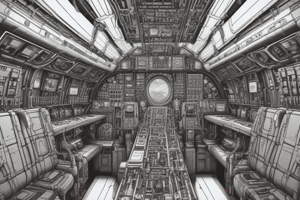Podcast
Questions and Answers
What were some of the early efforts in creating speaker devices in the mid-19th century?
What were some of the early efforts in creating speaker devices in the mid-19th century?
Thomas Edison built an electromechanical system using horns and magnets to produce sound.
When did practical loudspeakers become available?
When did practical loudspeakers become available?
Late 1800s
How did mechanical speakers in the early days of speaker technology work?
How did mechanical speakers in the early days of speaker technology work?
They relied on the direct conversion of electrical energy into acoustic energy through a diaphragm.
What was a key advancement in speaker technology around the mid-twentieth century?
What was a key advancement in speaker technology around the mid-twentieth century?
How do electrostatic speakers produce sound?
How do electrostatic speakers produce sound?
What is the main principle behind magnetic speakers?
What is the main principle behind magnetic speakers?
How do magnetic speakers produce sound?
How do magnetic speakers produce sound?
What advancements have allowed for refinements in speaker design over time?
What advancements have allowed for refinements in speaker design over time?
What benefits do electrostatic speakers offer over mechanical ones?
What benefits do electrostatic speakers offer over mechanical ones?
How do audio enthusiasts benefit from technological advancements in speaker design?
How do audio enthusiasts benefit from technological advancements in speaker design?
Flashcards are hidden until you start studying
Study Notes
Evolution of Speakers
Speaker systems have undergone significant development since their introduction in the mid-19th century. Early efforts to create speaker devices were made by inventors like Thomas Edison, who built an electromechanical system using horns and magnets to produce sound. However, it was not until the late 1800s that practical loudspeakers became available. Since then, advancements in audio technologies have led to various improvements, including changes in design, materials, and components used.
Mechanical Speakers
In the early days of speaker technology, mechanical designs were common. These speakers typically relied on the direct conversion of electrical energy into acoustic energy through a diaphragm. This involved moving a thin membrane (usually paper) back and forth with a voice coil driven by alternating current. The size of these speakers varied, with larger models producing louder sounds and lower frequencies.
Electrostatic Speakers
Around the mid-twentieth century, electrostatic speakers emerged as a more efficient alternative to mechanical designs. In these speakers, high voltage is applied between two metal plates, creating an electric field that moves air molecules when an AC signal is passed through them. As a result, sound waves are produced without any physical movement of parts. Although they are more complex to manufacture and require higher voltage power supplies, electrostatic speakers offer better frequency response and distortion levels compared to mechanical ones.
Magnetic Speakers
Magnetic speakers, also known as dynamic speakers, were developed in the late 1920s. They employ a similar principle as electrodynamic microphones, where a magnetic force drives a thin diaphragm back and forth. Inside the speaker cone, there's a permanent magnet and a coil wrapped around it. When an alternating current runs through the coil, a varying magnetic field interacts with the permanent magnet, causing the diaphragm to move accordingly.
Over time, technological advancements such as computer modeling and advanced materials have allowed for refinements in speaker design, leading to enhanced performance across different types of speakers. Today, audio enthusiasts can choose from various options depending on their preferences and requirements, ranging from compact desktop models to giant concert speakers.
Studying That Suits You
Use AI to generate personalized quizzes and flashcards to suit your learning preferences.



